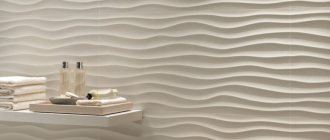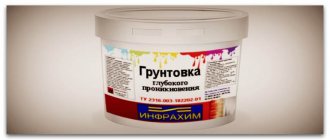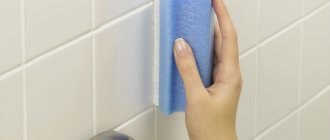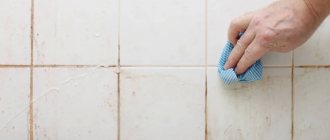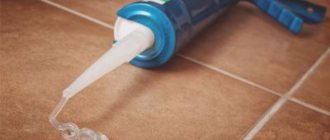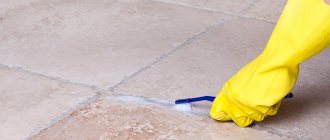Tile, without a doubt, is one of the strongest and most durable finishing materials, but it also has a weak point - the seams between the tiles. They lose their original appearance when the cladding still looks completely new, and the owners are at a loss as to how to remove the grout from the tile joints, and whether it is worth doing it at all. I propose to figure out when restoration of seams is really needed, and what methods can be used to remove damaged material without damaging the base.
Untidy seams spoil the impression Source freelancehack.ru
Does old grout need to be replaced?
The need to replace old grout may arise for at least several reasons:
- You have decided to change the design somewhat and choose a brighter, or, conversely, less shade for the joints in order to emphasize the originality of the tile. Quite often, this method is practiced in cosmetic repairs without changing ceramics, which allows you to create literally new conditions.
- The reason for replacing the old grout is its deterioration, which occurs due to insufficient quality and imperfection of the material processing technology. For example, porcelain stoneware is obtained by firing it in a kiln at more than 1000 degrees, which cannot be done with grout.
- The work on tiling the walls was carried out poorly, as a result of which the material was damaged and began to have an unsuitable appearance.
- Sometimes it becomes necessary to partially or completely replace the tiles, and then the grout is completely removed.
To seal the seams between the dies with a new fugue or other similar material, it is necessary to remove the old one from it. This is necessary in order to ensure a stronger retention of fresh material.
To understand how to remove old grout from tile joints in a bathroom or kitchen, you should first become familiar with all types of materials that are used to seal joints. They are roughly divided into the following varieties:
- Cement-based is the most inexpensive and common type of joint sealer. It has good water-repellent properties, but without special water-repellent components it cannot be used for bathrooms. It is in this type of grout that mold most often occurs if it was chosen incorrectly and not applied according to technology.
- Epoxy-based is a special type of high-strength decorative materials that perfectly protects tiles and walls from getting wet. It is insoluble in water and has a resinous structure.
- Silicone is a highly effective type of joint sealing material that is used to seal surfaces that are in regular contact with water. They do not form cracks, maintain tightness and provide an attractive appearance.
For each of the listed types of materials, a different product is used to seal the seams between ceramics and porcelain stoneware, because today there is no universal one.
The fact is that they have their own specific properties and have a unique composition, and therefore will interact with different substances in different ways.
For example, silicone is dissolved by vinegar, but cement compositions do not change in any way under its influence.
We also recommend watching - Grouting tiles in the bathroom: types, how to choose and use
Do you think it is worth changing the grout between the seams?
Not really
Why remove grout from tile joints?
The tile joint must be filled and treated with a hardening compound; it transforms the surface, giving it a finished look.
Despite the positive and important side of seams, they quickly lose their appearance. They begin to crack, lose color, and mold may also appear.
The appearance of these deformations can be influenced by the following factors:
- The composition is not selected correctly, the characteristics of the composition do not correspond to the performance characteristics;
- The mixture was prepared incorrectly and did not comply with the required proportions stated by the manufacturer;
- In the care of surfaces, products were used that destroy the structure of the hardened composition;
- The appearance of mold can be caused by insufficient ventilation of the room;
- The compound was applied unevenly along the seam.
If all of the listed violations were made during the application of the composition, this will subsequently lead to damage to the coating; it is impossible to correct the situation. In such a situation, it is necessary to completely remove the product and apply it again.
Individual protection means
To safely remove grout and various grouts from the joints between tiles, you must first of all follow safety precautions.
This is an important point, because means for softening hardened compounds are quite caustic and chemically active.
If it comes into contact with the skin, it can cause irritation and discomfort, not to mention allergic symptoms. Therefore, when starting work on removing old mortars and other putties from the joints between tiles, it is necessary to use personal protective equipment. These include:
- Rubber gloves are the main protective accessory that will protect your hands from all kinds of negative reactions from acids and alkalis. Thin medical ones may not be useful when working with some types of drugs.
- A mask or respirator is an especially important accessory if work is performed in a dry, mechanical manner. In this case, a lot of dust is generated, from which you need to protect your respiratory organs.
- Workwear is an element of personal protection that will protect against contamination generated during work. This also includes shoes.
Useful tips
The following recommendations will help reduce the amount of cleaning after the renovation is completed:
- after grouting the seams, you need to wipe each tile with a wet cloth, this will reduce the amount of contamination;
- It is necessary to remove the remains of the fugue immediately after finishing the work, because after polymerization and adhesion to the tile, it will be more difficult to remove stains;
- It is better to cover decorative patterns on the tiles with masking tape, because it is sometimes impossible to remove the sealant that gets into them (if the grooves are too deep);
- When carrying out grouting work in rooms with high humidity, additional ventilation must be provided. If this rule is not followed, the cement composition may not dry out completely and will crumble over time.
It is better to remove grout from the tiles immediately after finishing the repair work. If the mixture has time to completely harden, the effectiveness of the available methods will not be enough, and you will have to buy special products.
Softening compounds
Depending on the technology and materials, there are 2 ways to remove grout from the seams of wall or floor coverings:
- Mechanical is an effective method, but very labor-intensive. To remove grout from the joints between tiles, you will need the appropriate tools. This can be a spatula, a scraper, and in some situations a screwdriver helps. But for high-quality and quick removal of the composition, it is better to use a universal tool with attachments: various spatulas, scrapers and other devices. For ease of work, it is recommended to use a vacuum cleaner.
- Chemical is a reliable method for removing grout joints. They are various liquid or semi-liquid, gel-like compositions, which, as a result of a certain chemical reaction, literally dissolve the fugue, soften it, making it elastic and pliable, then it still needs to be removed mechanically. Therefore, this method is also called combined.
If everything is clear with mechanical procedures, then with chemical procedures the situation is a little different. Such materials, due to their active formula, literally dissolve solid mixtures, forming a soft or liquid mass, which is then quite easily removed from the seam mechanically.
It is important to know! If epoxy resins were used to seal the seams between the tiles, then it is better to entrust the work of removing it to experienced craftsmen, since after drying such materials become hard as stone.
If you nevertheless decide to use mechanical methods for removing grout from the seams of tiles or porcelain stoneware, then there are several types of reagents on sale that effectively affect the grout:
- Products for cement grout – Valo Clean . A highly effective solvent that has a significant effect on various types of cement compositions. It is usually used if mold has formed in the seams and fungus has developed. The composition has strong antiseptic and disinfecting properties.
- Keranet – special types of acid-based chemicals that are used to dissolve fugue mainly on ceramic tiles. The acid is a dry powder with a high concentration of the active substance, and is also sold in the form of a liquid solution prepared on the basis of organic acid.
- Litostrip is a special active substance that is used to effectively remove epoxy-based grout.
They provide a high degree of purification and quality removal of the mixture from the joint. The principle of working with the solution is as follows: the composition is stirred and applied to the seams, after leaving for a certain time it is removed mechanically using a spatula. It is important to know! When deciding to purchase an organic acid to remove grout, keep in mind that it is not recommended for marble, natural stone, or glazed ceramics. The substance may cause damage to decorative coatings.
How to wash off porous?
Tiles with a porous surface are more difficult to clean than matte, glossy, or even textured tiles . Any dirt, including from grout, is literally absorbed into such a surface.
Mechanical treatment using brushes and scrapers will help solve the problem. If the grout has not set yet, you can clean it off with a rag soaked in vegetable oil.
The following composition can help with processing:
- Pour 3 tbsp into a container. soda, pour in 3 tbsp. vinegar and the same amount of lemon juice.
- Add 1 liter of water.
- Stir.
- Using a rag or napkin, thoroughly clean tile by tile, paying attention to any uneven surfaces on the porous surface.
If simple grout removal methods do not help, you can use professional acid removers.
Chemical composition
Each product for removing old grout from joints on a ceramic or porcelain tile has its own properties, which is determined by the components it contains.
It is important to perform all operations correctly so that no traces remain on the surface of the tile after the reagents themselves.
Therefore, we will consider the properties and composition of preparations for each type of fugue.
For cement-based grouts
For cement-based grouts, compositions are used based on organic acids. They are similar in their properties to hydrochloric or sulfuric acid, but are not dangerous to humans, since when interacting with other substances they do not emit acrid smoke or various fumes.
When working with them, you should be very careful not to get the composition on your hands, as it can cause allergic reactions.
Suitable not only for grouts, but also for concrete and various adhesive mixtures. Before use, the contents of the bucket must be mixed with water and shaken thoroughly until smooth. Clutoclean and Litoclean Plus products have these properties.
Interesting to know! Do you want to save money, but grout removers are quite expensive? You can use the folk method using citric acid, vinegar and laundry soap. All this is mixed with water and applied to the surface that needs to be cleaned.
For epoxy compounds
Epoxy-based grouts are highly reliable and durable, which is good if the repair is done forever and bad when you want to change it. This is due to the natural physical properties of the resin, which hardens and becomes like stone.
The average service life of such joint sealing is usually at least 30 years.
To combat stains based on epoxy resins, it is recommended to use the product Litocol, you can also use the substance in the form of a gel. In fact, this drug is universal, as it is able to successfully dissolve fat, oil, foam, ink and wax.
The product is universal, as it can be used to clean grout from all types of tiles and is diluted to the required consistency with water. It is a concentrated alkaline solution.
For silicone sealants
To remove silicone grout from joints, it is necessary to use special potent preparations. There are many varieties of them on sale, all of them work approximately the same.
The most common effective actions include:
- Penosil Silicone R;
- Silicon-Entferner;
- Dow Corning OS-2;
- Antisil;
- Penta-840;
- Forch R551;
- R507.
All compositions for combating old silicone in the seams between tiles and in any other places contain acids. It is not without reason that it is present in many varieties, as evidenced by the characteristic smell.
It is important to know ! If the seams were filled with silicone sealant many years ago, then it can probably be dissolved with white spirit. This is an effective remedy, no doubt, but not for modern brands of silicones, because recent developments have become even more reliable and resistant to various chemicals. Only the materials described above can handle them.
Cleaning different types of grout
At the final stage of tiling, grouting of the joints begins. Many homeowners try to do this work themselves and make mistakes. Due to inexperience, joint filler gets onto the surface of ceramic tiles, which reduces the attractiveness of the masonry. What to do in this case and how to remove grout from the tiles?
Products for filling gaps between tiles consist of different materials, so before removing unnecessary formations, it is necessary to take into account the main component of the substance.
Fresh grout
This is a mixture that has not yet had time to harden on the tile. If this happens, do not take a rag and intensively wash off the grout. First of all, you need to consider the surface of the tile:
- On textured and uneven tiles, accumulation should be removed with a spatula made of “soft” material and a dry cloth.
- On glossy surfaces, use a damp sponge. Scrub the ceramics until the streaks disappear.
Cement grout
The mixture contains sand, which is why it is easily washed off with running water. The sponge is moistened and the cement is rubbed off with light tangential movements. The washcloth is washed several times. The cement joints between the tiles are treated with a sponge soaked in a solution of citric acid or a glycerin mixture to remove accumulated dirt.
Epoxy
Has good performance characteristics. It is evenly distributed over the working surface, has a high drying speed, and a variety of colors. Please note that epoxy grout can be removed from tiles within the first 24 hours after contact. On the second day, only a mechanical method will help remove the stain from the tile. Cleaning is carried out using chemical reagents.
Cleaning the cladding after repairs
When the repairs in the room are completed, they begin to restore order and general cleaning. After wet processing, all the shortcomings of the construction work become visible. There may be grout residue left on the tiles. How to clean tiles from grout on a tile surface?
There are several options:
- wipe with a piece of felt;
- soak stuck grout with vinegar solution;
- Try treating the contaminated area with dishwashing detergent.
Advice. After processing and removing the joint filler, allow a drying time of approximately 20 minutes. Then “polish” the damaged tile dry with a soft cloth.
How to clean grout from embossed tiles
The textured surface is not very convenient to clean. However, when processing such tiles, scratches and stains will not be as noticeable as on glossy tiles. Let's look at how to clean grout from tiles. The most effective method is to use dry lemon powder:
- wet the sponge with water;
- wring out the washcloth and sprinkle a little citric acid powder;
- Gently wipe the area where the mixture has accumulated, trying not to touch the seams between the ceramic tiles.
Instead of lemon juice, use a special mixture of vinegar and soda. The paste is applied to the remaining grout and after 15 minutes it is brushed.
Cleaning porous tiles
You need to tinker with this type of ceramic. The porous structure of the material absorbs any contamination. There is no way to do without mechanical influence. Brushes, hard fabrics, even scrapers and metal meshes are used for processing. Floor slabs are especially difficult to wipe down. If the residues are completely fresh, then a piece of felt dipped in vegetable oil will help remove them. Tile with a porous structure can be washed with special chemicals - solvents and acidic reagents, specially designed for deep penetration into the material.
Treating cracks with steam and covering with a masking compound
In addition to chemical and mechanical methods of removing sealant from the joint between tiles, you can use hot steam. The fact is that silicone usually withstands temperatures up to 90 degrees, and steam is much hotter, so it has a destructive effect on sealants and effectively removes it.
In such a situation, you need to work as follows:
- Direct the steam stream to the area to be treated and hold for a few seconds. During this time, the sealant literally peels off from the base.
- Afterwards, using a hard-bristled brush and water, the material is removed from the seam with vigorous movements. Typically, exposure to a concentrated jet of steam occurs simultaneously with mechanical removal of the sealant, that is, special brushes are used.
If the place needs to be restored without removing the old grout, then cover it with a special pencil with a waterproof filler or cover it with a water-based composition.
When to remove grout from tile joints
The process of removing old composition can lead to damage to the tiles. To prevent this from happening, it is necessary to remove the seams when they have reached the highest degree of deterioration.
Before starting work, the seams must be thoroughly cleaned to understand the condition of the seam.
The main signs that tell us that it is necessary to update the tile joint:
- The seam is cracked, voids have formed, the integrity of the seam is broken, it crumbles;
- Mold or fungus has formed on the surface of the seam;
- The seam has lost its original appearance and the distance between the tiles has increased.
For other minor damage, there is no need to completely remove the old compound; it is enough to sand the surface with sandpaper and renew the seam with a fresh mixture.
Application of chemical reagents
Don't know how to remove old grout from ceramic tile joints? An effective method is chemicals. For each type of fugue, you need to choose your own cleaner.
Let's look at an example of using cement removers using Sopro ESE 548 solvent:
- First of all, you need to apply the composition and wait for at least 20 minutes.
- After the joint filler has softened, mechanical removal begins using a scraper or jointer.
- The separated fugue residues are removed with a wet rag or sponge.
After the surface has completely dried, you can begin filling the new composition.
If the seams were filled with a thick layer of silicone sealant, then a chemical agent, for example, Penta-840, is applied twice, after removing the top layer or most of it from the joint.
How to clean grout from tiles after renovation?
Cleaning tiles after grouting, when the seam has completely hardened, will help with cleaning agents, but you need to be prepared for their use. Following the instructions guarantees a good result. Main stages:
- Preparation. Wear rubber gloves, goggles and a respirator if caustic agents are used for cleaning. If possible, open a window indoors.
- Application of the solution. The cleaning agent is used spot-on, applying only to contaminated areas. You can use a sponge or brush with unnatural bristles.
- Expectation. Before removing the remaining mixture, you must wait 15-20 minutes for the cleaning composition to react with the fugue.
- Scrubbing. Take a sponge or soft brush and remove the compound from the tiles in a circular motion.
- Rinse the tiles with water to remove any remaining detergent and grout.
Mechanical removal
Removing old grout from the joints between the tiles on the floor and walls causes a lot of hassle, because it is already a hardened material that has acquired its maximum strength. Therefore, you will have to work hard, especially if you decide to use a mechanical method.
This is an effective method, but without folk recipes and professional remedies, the process will take much more of your time. Let's look at the most popular and accessible technologies using familiar tools.
Painting knife
The thin replaceable blade makes it convenient, but when working with cement compounds it quickly becomes dull, so you will have to buy as many replacement blades as possible. Press the tip of the blade firmly against the seam and move along it several times.
Seam opener
A special device for removing silicone and cement compounds from joints. It has a comfortable handle and a specially shaped blade, which is made of very durable hardened steel.
Engraver Dremel
An effective electric tool that can be used to remove various compounds from joints. Equipped with special attachments.
Screwdriver
When using drills that are suitable in size and design, they are ideal for removing old mortar from the seam, but for more comfortable work, it is still better to soften the composition so that it is easier to remove it and not damage the front side of the tile.
Other power tools
In addition to the listed power tools, a multi-purpose tool can be used to remove old grout. This is a device that is equipped with various attachments, including those for sewing seams.
In any case, when using such tools, you should be extremely careful not to damage the coating. Otherwise, you will have to re-lay all the tiles, which will be very expensive.
Many people are interested in the question of how to remove epoxy-based grout? In this case, the use of a purely mechanical method will be ineffective. To combat such grout, professionals use methylene chloride. This is an effective active substance, but it is very difficult to obtain such a reagent. Therefore, it is better to immediately contact specialized companies.
Seam processing
Seams treated during the repair process lose their attractive appearance over time. Dirt accumulates in the space between the tiles, dust settles, and splashes get in. If the tiles are laid in the bathroom, then mold may even appear in the seams.
solve the issue of cleaning the joints between tiles using one of two methods:
- chemical exposure;
- mechanical restoration.
Traditional methods
To clean the tiles, improvised means can be used. Those drugs that are already in the household will be used.
Recipes with the following active substances can be used as effective
- lemon acid;
- glycerol;
- soda;
- aqueous solution of vinegar;
- soda with vinegar, etc.
Special preparations
Suitable products for treating seams are preparations that are aimed at caring for ceramic coatings and cleaning them.
Such products have a complex effect on seams:
- Remove the fungus.
- Remove dirt.
- Eliminates mineral deposits.
- Removes odors.
Effective products include products from GlutoClean, Ceresit, Kilto, etc.
Mechanical methods
Contaminants that have accumulated between the tiles can be removed by mechanical action. One of the simplest options is to use sandpaper . But the use of this method requires thoughtful action and accuracy.
The sandpaper itself must be used so as not to scratch the tile. To do this, the working side must be very thin - no wider than the distance between the tiles. After sanding has been done, the surface should be washed with water and dried.
You can protect yourself when carrying out such important work by sticking masking tape to the edges of the tiles, along their perimeter.
Traditional methods
You can also use folk remedies to remove old hardened grout based on cement and silicone. The most popular include:
Vinegar
To prepare the solution, mix water and vinegar in a 1:2 ratio. Cover the required area with this substance, and after half an hour, remove with a sponge and rinse with water.
Glycerol
An effective household chemical that is diluted in a ratio of 1:3. Cover the area with it for an hour, then clean it with a plastic spatula and rinse with water.
White spirit or kerosene
Suitable for removing old silicone joint fillers. Ineffective against new materials.
Ammonia
Suitable for combating fungus or mold formations. Dilute like vinegar and apply to the damaged area for 20 minutes.
Relief tiles
You can remove grout from the surface of relief tiles using home remedies. It is most convenient to use cleaners that contain acids, for example, a bathroom cleaner. A similar substance is applied to a sponge and distributed over the contaminated surface. The acid will quickly dissolve fresh grout; just remove it with a damp cloth.
Recommendations from experts
Remember, old hardened grout must be removed carefully so as not to damage the front surface of the tile. This can be done either mechanically or chemically, but it is important to choose the right compositions.
For example, substances based on organic acids can be used to remove cement fugues. To combat silicone joint fillers, acidic substances are also used, which soften the composition, making it mushy.
It is important that when removing any type of grout, you must first take care of your own safety and use at least gloves and a mask, because acid preparations have a negative effect on the human body.
How to clean a raised surface?
Spectacular design with relief tiles adds originality to the interior. But cleaning an uneven surface with grooves can be quite difficult.
You can use a recipe based on citric acid powder, a composition of soda and vinegar, as well as white spirit diluted with water (2 tablespoons of product per 500 ml of water).
One effective method is the use of citric acid.
Procedure:
- Soak a washcloth in water.
- Squeeze.
- Pour ½ tsp onto the working side of the washcloth. citric acid powder.
- Allow the powder to moisten.
- Clean the tiles.
Another cleaning method is based on the use of soda and vinegar:
- pour 3 tbsp into a container. soda;
- pour in 2 tbsp. vinegar;
- stir;
- apply the prepared product to the tiles;
- stand for 10 minutes;
- wipe with a damp sponge.
The sponge should not touch the seams between the tiles.
Removing fresh putty
It is easier and more economical to remove fresh putty for joints between tiles, because the composition has not yet hardened and is very pliable. To do this, you need to have several sponges and buckets of water with you. Often wetting the sponges, the surfaces are carefully wiped so as not to damage the fugue already present in the seam.
It is necessary to carry out the procedure until no whitish spots are visible on the surface. The final wash is done after drying with detergent.
Partial removal of the top layer of grout
To clean the grout from the tiles, it is enough to use chemicals. How to remove grout?
- Using a thin paint brush, apply the chemical to the seam.
- Leave for 5 hours until the grout layer softens.
- Use a paint knife or screwdriver to remove the filler.
Folk remedies are often used to work with tile joints. In order not to spend money on expensive chemicals, you can prepare effective solvents at home. Ordinary vinegar and ammonia have a destructive effect on the surface layer of putty. Citric acid and a mixture of glycerin and water also effectively cleans tile grout.
Tips for carrying out work
Removing the joint mixture is not very difficult, but it is a labor-intensive task. It can be significantly easier if you follow simple recommendations.
- The process of opening the seams is accompanied by copious dust. Furniture, household appliances, etc. should be removed from the premises.
- The room should be well ventilated, especially if chemical reagents will be used.
- Acid solvents should not be used when working with marble and porcelain tiles.
- To find out if there is mold on a material, you can use hydrogen peroxide. It is also used to bleach darkened jointing compound.
Getting rid of old grout is not very easy, but you can do it if you want. You must be patient and carefully perform all labor-intensive operations. Then the tile will remain unharmed and can be rubbed with a new compound.
Using electrical devices
For beginners, this is the most dangerous method, since there is a high probability of damaging the tiles. For these purposes I use a drill with a small attachment, a grinder, and a screwdriver with a brush attachment. To do this, you must have some experience working with the tool.
To remove old grout using a drill, proceed as follows:
- Select a drill of a smaller diameter, otherwise damage to the tile cannot be avoided;
- The drill is immersed from the edge of the seam, moving it smoothly towards the center, while the device should operate at medium speed;
- Remaining material is removed with a medium-hard brush.
Overview of methods
Painting and whitewashing seams
The easiest and almost instant way to update tile seams is to tint them. This method has one significant drawback - the effect will last no more than six months, after which the grout will need to be renewed again. Also, most paint compositions cannot be used in humid environments.
Another non-radical way to improve seams is to apply a new grout material on top of the old one. This operation is only possible if the seams are deep enough. New grout will need about two millimeters of depth.
All necessary consumables can be purchased at any hardware or hardware store.
If you decide to use paint compounds, then it is important to know that they can be used not only to renew seams, but also to restore damaged areas. That is, the paint can be applied not only over the old grout, but also used as a grouting material, only this will require applying a larger layer.
The paint is quite easy to use. The first step is to thoroughly clean the area from possible contaminants, for example, plaque or mold. Then you need to carefully apply the paint to the tile joint and wait for it to dry.
Painting seams
If you catch a tile during the touch-up process, you need to remove the excess with a rag. The time required for the composition to dry is indicated on its packaging. There you can also find some recommendations for its use.
Return to content
DIY tile cleaning
Fresh grout can be removed with a damp rag. If the material has already dried or several days have passed, specialized means are used:
- If you plan to grout the joints between clinker tiles, it is recommended to treat the products with a special compound - Sopro AH 737 - before performing the work. It covers the finishing material, which is characterized by a porous structure. If this is not done, you will not be able to clean the surface in the future, because the grout will get into the pores of the tile. The same applies to polished porcelain tiles.
- Before application, the product must be diluted with water.
- An acid-based cleaning agent is applied to the contaminated areas, avoiding the joint between the tiles. The substance will foam, which is normal, because it reacts with the components of the material.
- Removing old grout requires additional use of a brush.
- After completing the cleaning process, you need to remove any remaining substance with a damp cloth.
Some tips and necessary tools
For work, prepare a plastic brush, spatula, and rags. The use of metal abrasives is prohibited, as they can damage the tiles. In the case when you plan to remove grout that has already dried, you need to put in some effort. If the surface of the finishing material is heavily contaminated, first remove the excess substance with a spatula. When doing this, you need to be careful and try not to touch the tiles. If the protective composition Sopro AH 737 is not at hand, the porous coatings are moistened during the grouting process.
Rules for working with cleaning products
Most grease removers - both homemade and store-bought - can cause an allergic reaction, poisoning, or, if actively inhaled, a burn to the lungs.
To work with household and folk chemicals, you must strictly follow the safety rules:
- Cover your clothes with a long, thick apron;
- be sure to wear rubber gloves;
- do not lower your head low to the surface to be cleaned so that the acid vapors do not burn your throat and lungs;
- read the instructions for the purchased product;
- remove all food products from the table and kitchen counter;
- Make sure that children and pets do not have access to the kitchen.
After cleaning, wash your hands, face and neck very thoroughly, it is even better to take a shower with shampoo and soap. Rinse the gloves thoroughly, wash the apron in the machine. After cleaning the kitchen, it is better to immediately throw all clothes into the washing machine.
Before work, it also makes sense to make sure that the window in the kitchen is open, and if possible, you should also turn on the hood. You should not inhale fumes from household chemicals or vinegar - they can cause a real burn to the larynx and mucous membranes.
After washing the tiles, the window should be left open for at least 30 minutes in winter, and for two hours in summer, so that all the toxic fumes are blown outside.
Introduction
At the final stage of repair work on laying tiles, grouting of joints begins. Grouted seams prevent moisture from penetrating between the slabs. As a building shrinks, trim can also move, and seams provide this space for it to move. At the same time, the seams help hide the difference in calibers. Grout for tile joints is also called “fugue”. During home renovations, two types of fugue compositions are used - cement and epoxy. After processing the seams, stains and traces of grouting inevitably remain on freshly laid ceramics. The problem is complicated by the fact that the fugue dries quickly and it becomes more difficult to wipe it off. The decision on the best way to wipe off the dried fugue mass from the tiles and how best to do this also depends on the type of surface of the tile ceramics.
How to prevent contamination?
It is almost impossible to avoid traces of grout when laying tiles. But it is quite possible to minimize the area of pollution by taking the following measures:
- stick masking tape or adhesive tape around the perimeter of all joints, which will protect the surface of the tile from dirt;
- cover adjacent areas with cellophane film, not forgetting the floor and plumbing.
You need to glue the tape so that its edges fit tightly to the surface of the tile and to each other. This will prevent the putty from leaking and will allow you to process the seams with high precision and a clear contour.
You can use several fixing agents at once - seal the perimeters with masking tape, and seal the joints with tape and secure them with furniture staples.
Preparing for work
Before starting work, clear the room as much as possible. All furniture and equipment that cannot be removed are covered with film or rags. To protect the flooring from scratches, old newspapers are laid out in several layers next to the walls, and the surface of the baseboards is covered with masking tape.
Important!
Be sure to prepare personal protective equipment. To prevent grout crumbs from getting into your eyes, wear plastic glasses. To protect against silicate dust, use a respirator or a regular gauze bandage. Protect the skin on your hands with thick rubber gloves. Open areas of the body are covered with clothing.
Work begins by wiping the tiles with warm soapy water. This will help fill the tile with moisture, remove dirt and protect the edges of the ceramic coating from accidental chipping. Then tap the tile with a rubber hammer to find out if there are any voids underneath. If such are found, a mechanical method cannot be used to remove the old grout from the tile joints. It will lead to destruction of the cladding and the need to completely remove the tiles.
Basic cleaning rules
An important rule is that the sooner you start removing traces of grout from the tiles, the easier it will be to wipe off.
This principle applies to all types of tiles, except glossy and polished. It is worth paying attention to the fact that the approximate time for the initial drying of tile grout is 30 minutes. After this time, you can wash the cladding with warm water for the first time after installation. In order to better understand how to clean fugu from tiles, you need to get answers to the following questions:
- What material is the grout made of?
- How wet is the grout mixture?
- What is the surface of the tile?
You should also follow these rules:
· For cleaning it is better to use a sponge or foam rubber. You can also wipe off stains with felt, burlap or other hard cloth. · You can wipe dry and get rid of white residue from used cleaning products using a felt glove. · It must be remembered that movements in the process of cleaning tile ceramics should be soft and careful. This is especially true for polished glossy surfaces. You need to be very careful with it. · To remove fugue marks from a polished surface, do not use abrasives or abrasive-based detergents. · When trying a new safety product, it is better to test it on a small area of tile.
· To apply cleaning chemicals, it is better to use an old toothbrush. A wire brush cannot be used. · It is better to remove puffer from a vertical surface from top to bottom. On a horizontal surface, begin cleaning from the far corner to the door. · When removing dirt from ceramics, use thick masking tape to seal the seams. It will prevent solvent or other substances from getting onto the seam. If the product gets on the seam itself, it is better to immediately remove it with a rag or sponge. · We recommend using rubber gloves for cleaning work. Also, if you use chemicals, you should wear a respirator for protection. · At the end of the cleaning activities, you can treat the seam areas with products containing fungicides. They will reliably protect the tile layer from mold and mildew. You can also apply water-repellent impregnation to the seams.
Safe products and tools
To remove the grout, use a special scraper.
You can clean the grouting material from the floor and walls with a scraper, brush or pumice stone. This is a monotonous and difficult way to get rid of dried fugue. It takes a lot of time and effort, but the risk of damage to the tile coating is minimized.
Before you wash the grout off the tiles, try to initially remove dirt in a small area with a scraper or brush. Decide which tool is more convenient to work with. For best results, wet the stains and, with some effort, remove them.
Safe chemistry
You can clean the tiles from the fugue after repair by using special chemical liquids for cleaning ceramics from mortars. As a rule, these are acid preparations to destroy the remains of epoxy or cement fugue. Before starting work, you need to test the detergent on a small, inconspicuous area. It is also recommended to protect all surfaces made of synthetic materials, such as PVC, acrylic, etc.
Choose products from well-known manufacturers, read the composition and pay attention to what type of fugue the product is intended for.
Liquids for cleaning cement and epoxy deposits:
- Prosept Cement Cleaner. Concentrated liquid effectively removes old stains and stains. Before washing the grout from smooth and textured tiles, the detergent must be diluted with water 1:5. Spray the liquid onto the work surface with a spray bottle. After ten minutes, remove the residue with a damp sponge or lint cloth. Afterwards, thoroughly wash the surface with clean water 1-2 times.
- Fila CR10. Professional cleaner for removing epoxy fugue residues. Removes stubborn and old stains. Shake the container with liquid before use. Apply undiluted product with a brush to the entire surface of the dirt. Leave for 15-25 minutes. The most stubborn stains can be scrubbed with a stiff brush or spatula and rinsed thoroughly with water. Repeat if necessary.
- Atlas Szop. Cement residue cleaner. The liquid effectively removes both fresh and old cement stains on the ceramic surface. The cleaner is not recommended for use on substrates that are unstable to its influence, for example, marble. Depending on the contamination, it should be diluted with water. To remove stains and deposits of cement fugue, the ratio of water and product will be 1:3; for old large stains there is no need to dilute it. Apply the solution to the stains with a sponge. Leave for 10 minutes and then remove any remaining residue. Rinse the surface thoroughly with clean water.
- Litokol Litonet Pro. Liquid cleaner for epoxy fugue residues. The jelly-like product removes marks and stains from ceramics of various textures and shapes. It even copes with dried dirt on the walls without running down. The cleaner does not need to be diluted. The product must be distributed evenly over the entire surface. Wait 25 minutes and remove with any remaining grout. Once cleaning is complete, rinse the tiles with clean water again.
- Clean Kiilto. Acidic liquid for removing building cement mortars. Before applying the cleaning product, you need to moisten the stains with water. Then use a sponge with solvent to treat all stains. Wait 20 minutes and clean the surface. Using a hard plastic brush can speed up the removal of dirt.
- Keranet Mapei. Acidic product for removing cement grout from tiles. Available in the form of a solution and concentrated powder. The main component is organic acid. Removes traces of cement mortar and does not damage the joints between tiles.
- Unicum. The concentrated product is intended for removing fugue and putty. It must be applied evenly and spread with a sponge onto the stain. After 20 minutes, wipe with a cloth and wash the surface of the cladding with water.
- Starwax. Cement based grout remover. Effectively removes old and stubborn dirt. The solution does not need to be diluted with water. It is necessary to apply the product to stains or stains, wait 15 minutes and use a plastic brush to remove the remaining fugue. Afterwards, rinse everything off with clean water and wipe the surface dry with a cloth.
